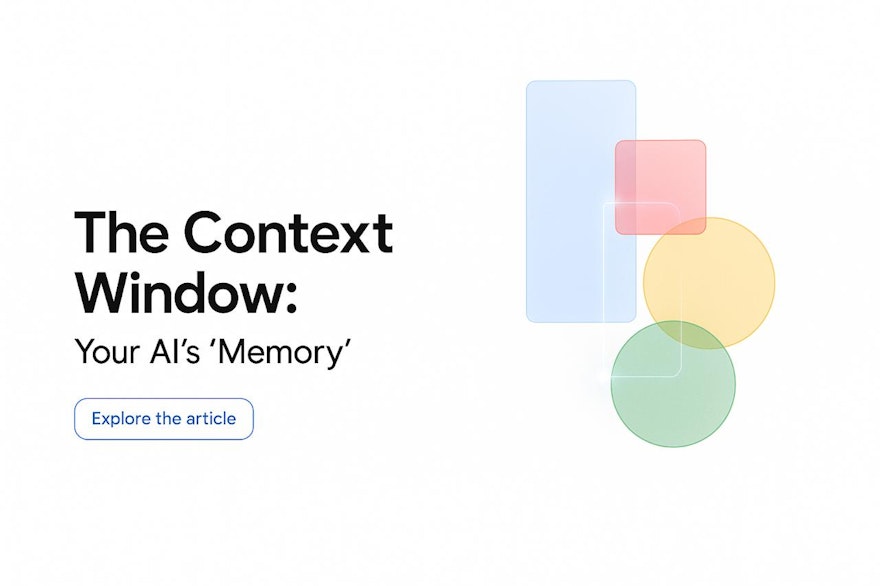The Core of LLM Understanding
When you interact with a Large Language Model (LLM) like ChatGPT, it genuinely remembers your past messages within the ongoing conversation. This ability is primarily due to what's called the "context window". The AI model’s working memory is analogous to human short-term memory or a computer’s RAM. Just as short-term memory helps us hold and process information temporarily, and RAM lets a computer quickly access the data it needs in the moment, an AI’s working memory determines how much information it can manage at once. This capacity limits how much context the AI can consider when answering questions, much like our short-term memory or a computer’s RAM sets boundaries on what can be processed simultaneously.
Simply put, imagine the context window as the amount of text the AI can "read" and "hold in mind" simultaneously. The larger this window, the more details the AI can remember from your conversation or analyze from long documents without "forgetting" what was previously said.
What is the Context Window?
Unlike humans who process words, LLMs break down text into "tokens". A token can be a single character, part of a word, a whole word, or even a short phrase. For example, the word "amoral" might have two tokens: "a" and "moral".
The size of the context window is always measured in tokens. On average, an English word is approximately 1.5 tokens. It’s important to note that the context window isn’t solely used for your text; it also includes elements such as system instructions (called "system prompts"), additional information for Retrieval Augmented Generation (RAG), and formatting. A system prompt is an instruction given to the AI to guide how it should behave or respond. For example, if you ask the AI to reply in a professional manner, that command is a system prompt: “Please answer all questions in a professional and courteous tone.”
Why is it so important?
A larger context window offers significant advantages for LLMs:
Improved Information Retention: The AI can remember more details throughout a conversation, preventing it from "losing track".
Processing Longer Texts: Models can analyze and summarize much larger documents, codebases, or datasets, which was previously impossible.
Advanced Reasoning: Increased context allows for more accurate, complex, and nuanced responses. For instance, Google's Gemini 1.5 Pro model was able to learn to translate a critically endangered language (Kalamang) by reading its sole grammar manual, demonstrating translation ability comparable to a human.
New Interaction Possibilities: The increased data handling capacity opens up entirely new ways for users to interact with AI, enabling more complex and comprehensive tasks.
Challenges of Large Context Windows
Despite their benefits, large context windows present challenges:
Computational Cost and Power: Processing larger blocks of text demands significantly more computational power, memory, and time. Doubling the context length can quadruple the computational need.
Latency: Inference can become slower as context length increases, which is problematic for real-time applications.
The "Needle in a Haystack" Problem: As the volume of text (the "haystack") grows, a model can struggle to pinpoint a specific, crucial detail (the "needle"). Its attention gets diluted, causing it to overlook the key fact—like missing a single sentence about a project's critical failure within a 200-page report. This drastically reduces the model's reliability and accuracy.
For a deeper dive, see the foundational paper on this issue: https://arxiv.org/abs/2307.03172
The Evolution of Capabilities
Context window sizes have grown significantly over time, marking a major step towards deeper understanding and broader situational awareness in AI systems. While early LLMs like GPT-2 were limited to around 2,048 tokens, modern models have seen an explosion in their capabilities.
Today, models like Anthropic's Claude 3 offer a 200,000-token window. OpenAI's GPT-4 Turbo and GPT-4o reach 128,000 tokens. Google Gemini 1.5 Pro features a standard 128,000-token window, with an experimental version going up to 1 million tokens, and research testing up to 10 million tokens. Projects like Magic AI are even aiming for 100 million tokens. This race to increase context is a key indicator of innovation and competition in the AI field.
The following table illustrates the evolution of context window capabilities:
Model | Context Window (tokens) | Release Year | Notes |
GPT-4 Turbo | 128,000 | 2023 | Optimized, lower-cost version |
GPT-4o (Omni) | 128,000 | 2024 | Multimodal (text, image, audio) |
GPT-4.1 | 1,000,000 | 2025 | Massive context window |
Claude 3 Opus | 200,000 | 2024 | Extended context, strong reasoning |
Claude 3.5/4 | 1,000,000 | 2025 | Latest Anthropic models |
Gemini 1.5 Pro | 1,000,000 | 2024 | Multimodal, large context |
Gemini 2.0 / 2.5 Pro | 1,000,000 | 2025 | Enhanced capabilities |
Balancing Power and Practicality
The context window is fundamental to the "memory" and understanding of Large Language Models. Its size, measured in tokens, directly impacts an LLM's ability to generate coherent text and handle complex tasks.
While larger context windows significantly enhance AI capabilities, they come with substantial challenges related to cost, performance, and security. Future LLM development will continue to focus on optimizing this critical component, seeking the "sweet spot" between processing power and practical usability. Understanding the context window is therefore crucial for anyone looking to make the most of current and future AI tools.
Understanding the context window is especially relevant to GPT Workspace, as it directly influences how much information our current models—GPT-4.1 and GPT-4o—can remember and process at once. Both models offer a substantial context window of up to 128,000 tokens, making them highly practical for extended discussions, document analysis, and complex workflows. This capacity enables users to utilize long documents or interactions without frequently losing past context, which is essential for maintaining coherent, productive sessions in GPT Workspace.
